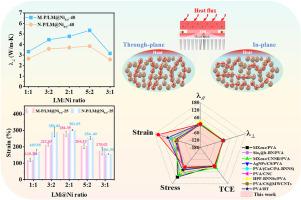Quasi-isotropically thermally conductive, electrically insulated, and recyclable flexible PVA composite film via magnetic field-induced liquid metal alignment
IF 9.8
1区 材料科学
Q1 MATERIALS SCIENCE, COMPOSITES
引用次数: 0
Abstract
Using polymer composites with elastic compliance as thermal interface materials (TIMs) effectively minimizes thermal contact resistance between the heat sink and the heat source, thereby enhancing the heat dissipation rate. Currently, most TIMs are obtained by incorporating high-modulus fillers into a flexible polymer matrix and constructing heat transmission channels oriented in the through-plane direction. However, the addition of excessive rigid fillers can compromise material softness and resilience, posing a significant challenge in preparing TIMs that balance excellent thermal conductivity with good flexibility. In this study, we successfully fabricated a super-flexible composite film with quasi-isotropic thermal conductivity, utilizing magnetic soft liquid metal (LM@Ni) nanodroplet and polyvinyl alcohol (PVA) as the primary components, through a magnetic field-induced technique. The M-PVA/LM@Ni5:2-40 composite film exhibits exceptional through-plane and in-plane thermal conductivities (5.34 and 8.93 W/m·K), attributed to the alignment of dense LM@Ni particles during PVA film formation, induced by external magnetic fields, and the formation of efficient heat conduction networks facilitated by Ni nanoparticles bridging deformable LM droplets. Furthermore, the thermal conductive anisotropy constants of the prepared M-PVA/LM@Ni films lie within a range of 1.77–3.06, demonstrating quasi-isotropic thermal conductivity. More importantly, the M-PVA/LM@Ni composite films also boast remarkable toughness (37.93 MJ/m3), high electrical insulation (3.9 × 109 Ω cm), and recyclability. These admirable features combined with the scalable fabrication process, make M-PVA/LM@Ni films promising for broad application prospects in the thermal management of high-power integrated electronic devices.

通过磁场诱导液态金属取向制备准各向同性热传导、电绝缘、可回收的柔性聚乙烯醇复合薄膜
采用具有弹性柔度的聚合物复合材料作为热界面材料(TIMs),可以有效降低散热器与热源之间的热接触阻力,从而提高散热速率。目前,大多数TIMs是通过在柔性聚合物基体中加入高模量填料并构建面向通平面的传热通道来获得的。然而,添加过多的刚性填料会损害材料的柔软性和弹性,这对制备具有优异导热性和良好柔韧性的TIMs提出了重大挑战。在本研究中,我们利用磁性软液态金属(LM@Ni)纳米液滴和聚乙烯醇(PVA)作为主要成分,通过磁场诱导技术成功制备了具有准各向同性导热性的超柔性复合薄膜。m -PVA/LM@Ni5:2-40复合薄膜表现出优异的通面和面内导热系数(5.34和8.93 W/m·K),这是由于在PVA薄膜形成过程中,在外部磁场的诱导下,致密的LM@Ni颗粒排列整齐,以及Ni纳米颗粒桥接可变形的LM液滴促进了高效导热网络的形成。此外,制备的M-PVA/LM@Ni薄膜的导热各向异性常数在1.77 ~ 3.06之间,表现出准各向同性导热性。更重要的是,M-PVA/LM@Ni复合膜还具有出色的韧性(37.93 MJ/m3),高电绝缘性(3.9 × 109 Ω cm)和可回收性。这些令人钦佩的特点与可扩展的制造工艺相结合,使M-PVA/LM@Ni薄膜在大功率集成电子器件的热管理方面具有广阔的应用前景。
本文章由计算机程序翻译,如有差异,请以英文原文为准。
求助全文
约1分钟内获得全文
求助全文
来源期刊

Composites Science and Technology
工程技术-材料科学:复合
CiteScore
16.20
自引率
9.90%
发文量
611
审稿时长
33 days
期刊介绍:
Composites Science and Technology publishes refereed original articles on the fundamental and applied science of engineering composites. The focus of this journal is on polymeric matrix composites with reinforcements/fillers ranging from nano- to macro-scale. CSTE encourages manuscripts reporting unique, innovative contributions to the physics, chemistry, materials science and applied mechanics aspects of advanced composites.
Besides traditional fiber reinforced composites, novel composites with significant potential for engineering applications are encouraged.
 求助内容:
求助内容: 应助结果提醒方式:
应助结果提醒方式:


